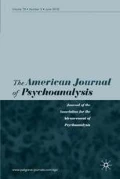Abstract
The rock album form, advantageously suited for the artistic expression of intrapsychic experience, has been virtually ignored by analytic writers. Remain in Light by Talking Heads is presented as an example of an album that effectively utilizes the potentialities of this form to give powerful and disconcerting musical expression to a variety of psychotic and schizoid experiences, bringing to life the formulations for these phenomena of Bion, Winnicott, Guntrip, Ogden, Grotstein and others. The album suggests a variety of mechanisms by which sound and music may serve both defensive and compensatory functions in relation to these phenomena.
Similar content being viewed by others
REFERENCES
Akhtar, S. (1995). A third individuation: Immigration, identity and the psychoanalytic process. Journal of the American Psychoanalytic Association, 43, 1051–1084.
Bick, E. (1968). The experience of the skin in early object relations. The International Journal of Psychoanalysis, 49, 484–486.
Bion, W. R. (1957). Differentiation of the psychotic from the nonpsychotic personalities. The International Journal of Psychoanalysis, 38, 266–275.
Bion, W. R. (1959). Attacks on linking. International Journal of Psychoanalysis, 40, 308–315.
Bion, W. R. (1962a).Learning from experience. Bath: Pitman Press.
Bion, W. R. (1962b). A theory of thinking. International Journal of Psychoanalysis, 43, 306–310.
Bowman, D. (2001). This must be the place: The adventures of the Talking Heads in the 20th century. New York: HarperCollins.
Britton, R. (1992). Keeping things in mind. In Clinical Lectures on Klein and Bion. (pp. 102–113). London: Routledge.
Brog, M. (1995). The phenomena of Pine's “four psychologies,” their contrast and interplay as exhibited in the Beatle's White Album. American Journal of Psychotherapy, 49, 385–404.
Cocks, J. (1986). Rock's renaissance man. Time, October 27, 1986, 78–82.
Emerson, K. (1985). David Byrne: Thinking man's rock star. New York Times Magazine, May 5, 1985, 54–57.
Fairbairn, W. R. D. (1940). Schizoid factors in the personality. In Psychoanalytic Studies of the Personality (pp. 3–27). London: Tavistock Publications Limited.
Fairbairn, W. R. D. (1941). A revised psychopathology of the psychoses and the psychoneuroses. In Psychoanalytic Studies of the Personality (pp. 28–58). London: Tavistock Publications Limited.
Freud, S. (1924). Neurosis and psychosis. SE, 19, 149–53.
Gans, D. (1985). Talking Heads. New York: Avon Books.
Grand, S. (1982). The body and its boundaries: a psychoanalytic view of cognitive process disturbances in schizophrenia. International Review of Psychoanalysis, 9, 327–342.
Grotstein, J. (1977a). The psychoanalytic concept of schizophrenia I. International Journal of Psychoanalysis, 58, 403–425.
Grotstein, J. (1977b). The psychoanalytic concept of schizophrenia II. The International Journal of Psychoanalysis, 58, 427–452.
Guntrip, H. (1965). Learning from experience by W. R. Bion. International Journal of Psychoanalysis, 46, 381–385.
Guntrip, H. (1969). Schizoid phenomena, objectrelations and the self. New York: International Universities Press.
Howell, J. (1992). David Byrne. New York: Thunder's Mouth Press.
Kohut, H. (1989). Observations on the psychological functions of music. In S. Feder, R. Karmel, &; G. Pollock (Eds.), Psychoanalytic explorations in music (pp. 21–48). Madison, CT: International Universities Press. (Original work published 1957)
Kohut, H., and Laverie (1989). On the enjoyment of listening to music. In S. Feder, R. Karmel, &; G. Pollock (Eds.), Psychoanalytic explorations in music (pp. 1–20). Madison, CT: International Universities Press. (Original work published 1950)
Meissner, W. W. (1986). Psychotherapy and the paranoid process. Northvale, NJ: Jacob Aronson.
Nass, M. (1989a). On hearing and inspiration in the composition of music. In S. Feder, R. Karmel, &; G. Pollock, (Eds.), Psychoanalytic explorations in music (pp. 179–194). Madison, CT: International Universities Press. (Original work published 1975)
Nass, M. (1989b). The development of creative imagination in composers. In S. Feder, R. Karmel, &; G. Pollock (Eds.), Psychoanalytic explorations in music (pp. 267–286), Madison, CT: International Universities Press. (Original work published 1984)
Nuetzel, E. (2000). Psychoanalysis and dramatic art. The journal of applied psychoanalytic studies, 2, 41–63.
Noy, P. (1989). The development of musical ability. In S. Feder, R. Karmel, &; G. Pollock (Eds.), Psychoanalytic explorations in music (pp. 63–78). Madison, CT: International Universities Press. (Original work published 1968)
Noy, P. (1993). How music conveys emotion. In S. Feder, R. Karmel, &; G. Pollock, (Eds.), Psychoanalytic Explorations in Music Second Series (pp. 125–149). Madison, CT: International Universities Press.
Ogden, T. (1979) On projective identification. International Journal of Psychoanalysis, 60, 357–373.
Ogden, T. (1982). Projective identification and psychotherapeutic technique. New York: Jason Aronson.
Ogden, T. (1989). The primitive edge of experience. New York: Jason Aronson.
Rappaport, D. (1967). The theory of ego autonomy: A generalization. In M. Gill (Ed.), The collected papers of David Rappaport (pp. 722–744). New York: Basic Books. (Original work published 1957)
Reese, K. (1982). The name of this book is Talking Heads. New York: Proteus Books.
Reik, T. (1953). The Haunting melody. New York: Grove Press.
Sella, M. (2001). Same as he ever was. New York Times Magazine, April 29, 2001, 44–49.
Shopper, M. (1978). The role of audition in early psychic development, with special reference to the use of the pull toy in the separationindividuation phase. Journal of the American Psychoanalytic Association, 26, 283–310.
Treitler, L. (1993). Reflections on the communication of affect and idea through music. In S. Feder, R. Karmel, &; G. Pollock (Eds.), Psychoanalytic explorations in music, second series (pp. 43–62). Madison, CT: International Universities Press.
White, T. (1996). Music to my Ears. New York: Owl Books.
Winnicott, D. W. (1960). Ego distortions in terms of true and false self. In Maturational processes and the facilitating environment (pp. 140–152). New York: International Universities Press.
Winnicott, D. W. (1965). Transitional objects and transitional phenomena. In Playing and reality (pp. 1–25). New York: Basic Books. (Original work published 1953)
Winnicott, D. W. (1989). Ideas and definitions. In Psychoanalytic Explorations (pp. 43–44). Cambridge: Harvard University Press.
Author information
Authors and Affiliations
Rights and permissions
About this article
Cite this article
Brog, M.A. “Living Turned Inside Out”: The Musical Expression of Psychotic and Schizoid Experience in Talking Heads' Remain in Light . Am J Psychoanal 62, 163–184 (2002). https://doi.org/10.1023/A:1015181228250
Issue Date:
DOI: https://doi.org/10.1023/A:1015181228250




